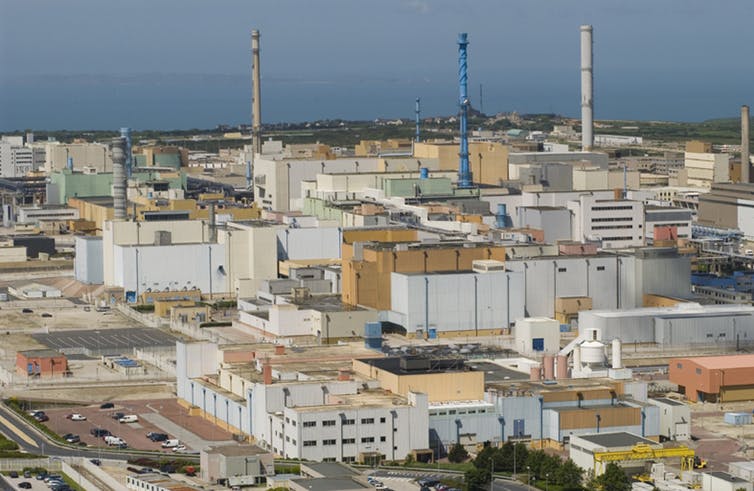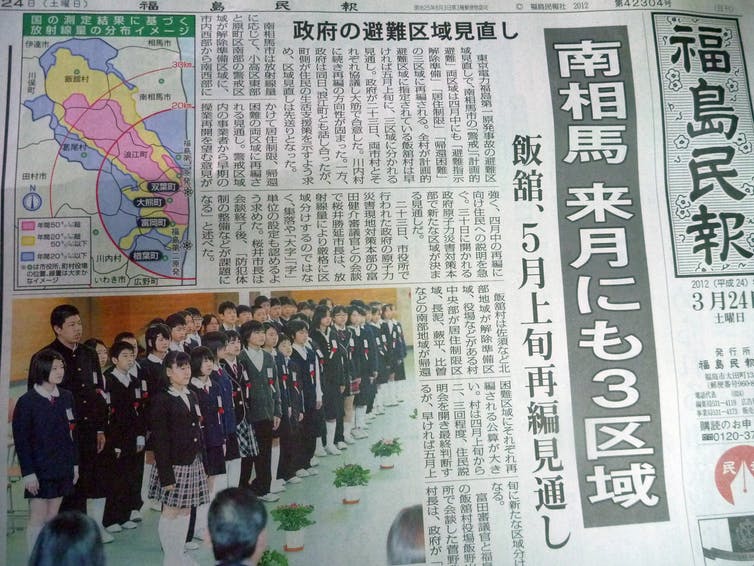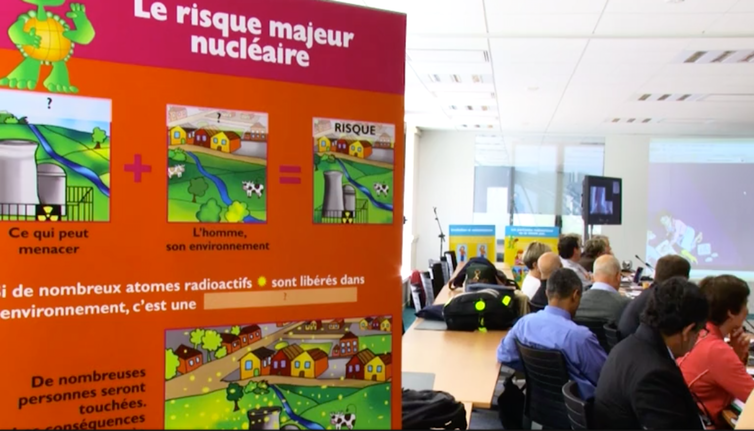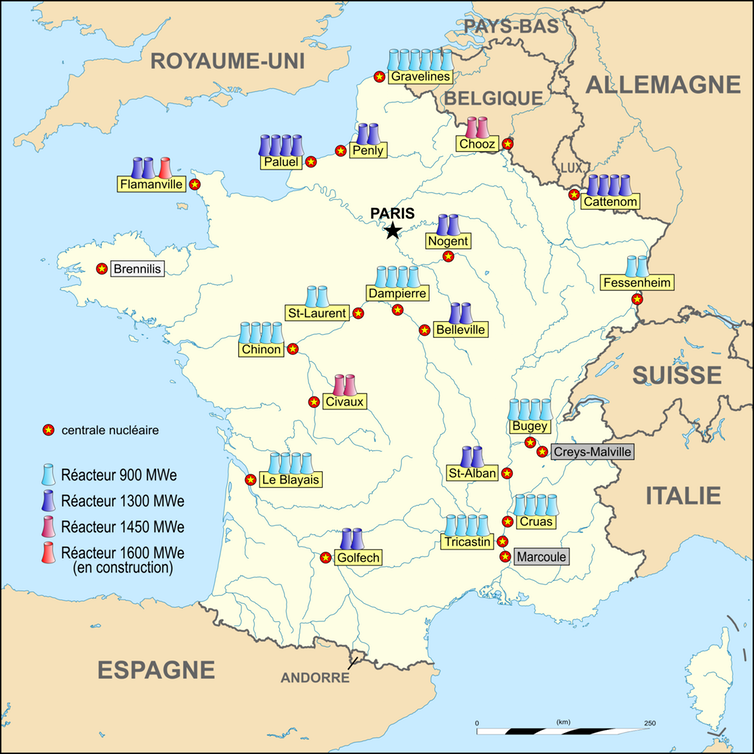What nuclear risk governance exists in France?
Stéphanie Tillement, IMT Atlantique – Institut Mines-Télécom
[divider style=”normal” top=”20″ bottom=”20″]
[dropcap]I[/dropcap]t will take a long time to learn all the lessons from the Fukushima accident, and even longer to bring about a change in the practices and principles of nuclear risk governance. Yet several major themes are already emerging in France in this respect.
Next Sunday, March 11, 2018 will mark the 7-year anniversary of the Fukushima disaster, when the Northeast coast of Japan was struck by a record magnitude-9 earthquake, followed by a tsunami. These natural disasters led to an industrial disaster, a nuclear accident rated 7, the highest level on the INES scale, at the Dai-ichi nuclear power plant in Fukushima.
In the aftermath of the disaster, the world was stunned at the realization of the seriousness and suddenness of this event, which, according to Jacques Repussard, Director General of the French Institute for Radiological Protection and Nuclear Safety (IRSN) calls for us to “imagine the unimaginable and prepare for it.” It confronts all those involved in nuclear safety with a critical challenge: how can we guarantee safety in the midst of unexpected events?
Beyond its unpredictable nature, this accident served as a brutal and particularly relevant reminder that nuclear energy, more than any other technology or industry, transcends all borders, whether they be geographic, temporal, institutional or professional. The consequences of nuclear accidents extend well beyond the borders of a region or a country and remain present for hundreds or even thousands of years, thus exceeding any “human” time scale.

La Hague nuclear waste reprocessing plant. Jean Marie Taillat/Wikimedia, CC BY-SA
Fukushima revealed that the safety of socio-technical systems with this level of complexity cannot be limited to only to a few stakeholders, nor can it be ensured without creating strong and transparent ties between a multitude of stakeholders, including nuclear operators, citizens, safety authorities, technical support, and government services. Fukushima calls into question the nature and quality of the relationships between these multiple stakeholders and demands that we reconsider nuclear risk governance practices, including in France, and then rethink the boundaries of the “ecosystem of nuclear safety,” to use the term proposed by Benoît Journé.
Learning from nuclear accidents: a long-term process
Immediately after the accident, the entire community of international experts worked to manage the crisis and to understand the dynamics of the accident in terms of its technical, human and socio-organizational aspects. A few months later, the European Commission asked nuclear countries to carry out what it termed “stress-tests” aimed at assessing nuclear facilities’ ability to withstand external stress (such as major weather events) and serious technical malfunctions. In France, this led to the launch of safety assessment reports (ECS) for the country’s nuclear facilities.
While the technical causes of the Fukushima accident were quickly understood, socio-organizational causes were also identified. The Japanese Fukushima Nuclear Accident Independent Investigation Commission found that the “collusion between the government, the regulators and TEPCO, and the lack of governance by said parties” was one of the major causes of the disaster. The accident also highlighted the importance of involving civil society participants in risk prevention and in risk management preparation very early on.

Volunteers from the town of Minamisoma, near the nuclear power plant. Hajime Nakano/Flickr, CC BY
Above all, it reveals the long-term need to plan and get equipped to manage a nuclear accident. Far too often, efforts concentrate on the emergency phase, the days or weeks immediately following the accident, leaving local stakeholders virtually on their own in the “post-accident” phase. Yet this phase involves major problems, involving, for example, the consumption of basic foodstuffs (water, milk, etc.), displacing populations and cultivating potentially contaminated land.
After the Three Mile Island (1979) and Chernobyl (1986) accidents caused the human and organizational aspects of safety measures to be considered, Fukushima marks a new era focused on examining inter-organizational relations and the long-term methods for managing nuclear risks.
The need for openness towards civil society
Although this term is sometimes criticized and even mocked as being a popular buzzword, nuclear risk “governance” refers to a very practical reality involving all the stakeholders, measures and policies that are mobilized to guide the decisions made primarily by the public authorities and the nuclear operators to better manage nuclear risks and help ensure greater transparency of these risks. This implies the need to reflect on how each stakeholder can participate, the material and immaterial resources that could enable this participation and software that could support and help coordinate it.

Public awareness, organized by the Nuclear Safety Authority. ASN, CC BY
In this sense, Fukushima serves as a powerful reminder of the need for greater transparency and greater involvement of civil society participants. Contrary to popular belief, the longstanding institutional stakeholders in the nuclear industry are aware of the need for greater openness to civil society. In 2012 Jacques Repussard stated: “Nuclear energy must be brought out of the secrecy of executive boards and ministerial cabinets.” And as early as 2006, the French Nuclear Safety and Transparency Act confirmed this desire to involve civil society stakeholders in nuclear safety issues, particularly by creating local information committees (CLI), although some regret that this text has only been half-heartedly implemented.
Of course, bringing about a change in practices and pushing the boundaries is not an easy thing, since the nuclear industry has often been described, sometimes rightly, as a world frozen in time. It continues to be burdened by its history. For a long time, nuclear safety was an issue reserved only for a small group of stakeholders, sometimes referred to as “authorized” experts, and traces of these practices are still visible today. This characteristic is embodied in the extremely centralized safety organization. Even the French word for a nuclear power plant, “centrale nucléaire” attests to the prominence given to centralization.

French nuclear power plants. Sting, Roulex_45, Domaina/Wikimedia, CC BY-SA
One thing is for sure, there must be an ongoing dialog between the communities. This implies taking the heat out of the debates and moving beyond the futile and often exaggerated divide between the pro-nuclear and anti-nuclear camps.
A form of governance founded on open dialog and the recognition of citizen expertise is gradually emerging. The challenge for longstanding stakeholders is to help increase this citizen expertise. The AGORAS project (improvement of the governance of organizations and stakeholder networks for nuclear safety) questions governance practices, but also seeks to create a place for dialog and collective reflection. A symposium organized in late 2017 provided the first opportunity for implementing this approach through discussions organized between academic researchers and operational and institutional stakeholders. The 2018 symposium (more information here: colloque2agoras@imt-atlantique.fr) will continue this initiative.
[divider style=”normal” top=”20″ bottom=”20″]
The original version of this article was published in The Conversation.





Leave a Reply
Want to join the discussion?Feel free to contribute!